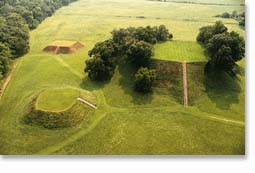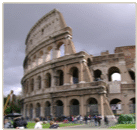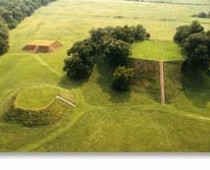Georgia’s Ancient Indian Cities
Kolomoki Mounds
| The large earthen pyramid at Kolomoki Mounds is one of several located throughout Georgia. |
Standing before one such structure at the Kolomoki Mounds State Park, I was overwhelmed by its sheer size. Looking up at it, it was difficult to imagine how anyone during this time period could have undertaken such a massive project. The structure I was looking at was a large earthen mound in the form of a truncated pyramid. It towered several stories above me and its base was larger than a football field.
That’s a lot of dirt! Considering this dirt was dug with simple stone tools and delivered by the basketload to build this massive monument, it is a true testament to the tenacity of Georgia’s earliest architects. The site is thought to have been the largest, most populous center north of Mexico during its time period.
Kolomoki Mounds consists of seven Indian mounds. Two burial mounds at the site have revealed the true level of the inhabitant’s artistry. These burial mounds were filled with exquisite pottery unlike anything that had been seen before in Georgia. Some of the pottery has been interpreted as having astronomical significance. For instance, some pots seem to have served as calendars marking important astronomical events such as the spring equinox and the winter solstice. Similarly, several of the mounds at Kolomoki State Park seem to have astronomical alignments.
Although today the mounds are covered with grass and trees, they would have originally been free of vegetation and covered with colored clays. The large mound was completely covered with white clay at one point in its history. Later it was covered with a red clay capping layer. Archaeologists have joked that these clay capping layers are so thick and hard that it would take dynamite and an earthquake to ever break through them.
Yet Kolomoki Mounds were just the beginning. Georgia’s ancient architects would reach the height of their accomplishments over the next 500 years with the arrival of a new people. These people came from the west, perhaps as far away as Mexico, and arrived in Georgia around 1000 AD. They would settle near Macon, Geogia and call their settlement Ocmulgee. It is now the site of the Ocmulgee National Monument, part of the National Park Service.
Ocmulgee Mounds
| Ocmulgee Mounds feature some of the largest pyramids in America yet few know they exist just an hour south of Atlanta. |
The sounds of drumbeats and singing were the first things I noticed as I walked towards the Ocmulgee Mounds National Monument Museum but the words were not in a language I recognized. Hundreds of people were sitting and standing around an open plaza area in front of the museum. Inside this plaza area danced two Native American males dressed in traditional warrior attire while a circle of drummers maintained the steady beat on a large drum and another Indian sang the haunting vocals to a song whose words I could not understand yet somehow made perfect sense.
I had arrived at the Ocmulgee National Monument during their annual Native American Celebration. Native Americans from all parts of the Southeast would perform their traditional dances throughout the day. Reenactors taught about Native American lifeways and demonstrated their hunting techniques as well as the ballgames they played.
The festival was worth seeing all by itself but I had come to see the mounds; thus, I walked past the many arts & crafts booths offering authentic Native American art and pottery and headed towards the mound complex.
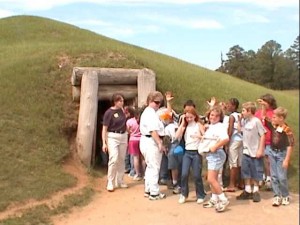 The first mound I approached turned out not to be a mound at all. Instead, it was an earth-covered building called the Earth lodge. After stooping down to enter the long, low entrance tunnel, I was able to stand fully erect again once fully inside. Before me was a circular room with fifty seats built into the floor around the inside wall . The three central seats were elevated above the other seats and were placed atop a large bird effigy built into the floor. A large fire pit was located in the center of the room and a large conch shell and even larger pottery vessel were located to one side of the room.
The first mound I approached turned out not to be a mound at all. Instead, it was an earth-covered building called the Earth lodge. After stooping down to enter the long, low entrance tunnel, I was able to stand fully erect again once fully inside. Before me was a circular room with fifty seats built into the floor around the inside wall . The three central seats were elevated above the other seats and were placed atop a large bird effigy built into the floor. A large fire pit was located in the center of the room and a large conch shell and even larger pottery vessel were located to one side of the room.
Pushing a button started an audio explanation of the building. It seems this was a type of council house where the Native American leaders discussed matters of trade, war, and politics. The pot held a ceremonial tea made from the leaves of Yaupon Holly trees, the only plant in the Southeast whose leaves have a high caffeine concentration. It seems the custom of drinking black tea predates the current Southern tradition by over a thousand years.
After exiting the Earth Lodge I could see another mound in the far distance. This mound seemed about the same height as the large mound at the Kolomoki site. Upon reaching the mound I climbed to its summit and realized somehow I was above the treetops. I could clearly make out the Macon skyline in the distance. I didn’t recall climbing this high but upon walking to the edge of the mound and looking down, I was amazed.
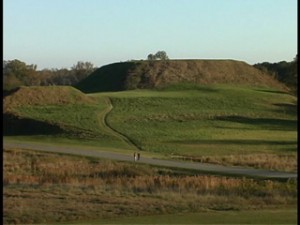 The builders of this large temple mound had ingeniously constructed it on the edge of a plateau. Thus, it rose 57 feet from the top of the plateau but an impressive 90 feet from the floodplain below. It would be this more impressive view that early Native Americans would have seen as they approached the site in dugout canoes from the nearby Ocmulgee River.
The builders of this large temple mound had ingeniously constructed it on the edge of a plateau. Thus, it rose 57 feet from the top of the plateau but an impressive 90 feet from the floodplain below. It would be this more impressive view that early Native Americans would have seen as they approached the site in dugout canoes from the nearby Ocmulgee River.
Standing at the base of this mound and looking up is truly a spectacle to behold. How many basketloads of earth must this construction have taken? How manly laborers must have toiled to build such a massive monument? And this was not the only mound at the site– there were several others though nothing near the scale of this mound.
It was while standing at the base of this structure that I realized the term “mound” was wholly inappropriate to express the true nature of this construction. Pyramid was a much better term. It resembled in many ways the various flat-topped pyramids found throughout Mexico and Central America.
The people who built this place arrived around 1000 AD and their own oral traditions tell how they originated further west in a place dominated by volcanoes, a possible reference to central Mexico. They brought with them large-scale corn agriculture, a product that also originated in Mexico. With this corn agriculture came the origins of two other southern traditions: grits and cornbread. Both of these items were major parts of these people’s diet. Yet within 200 years of arriving, the Ocmulgee complex had been abandoned. Archaeologists still are not sure why.

